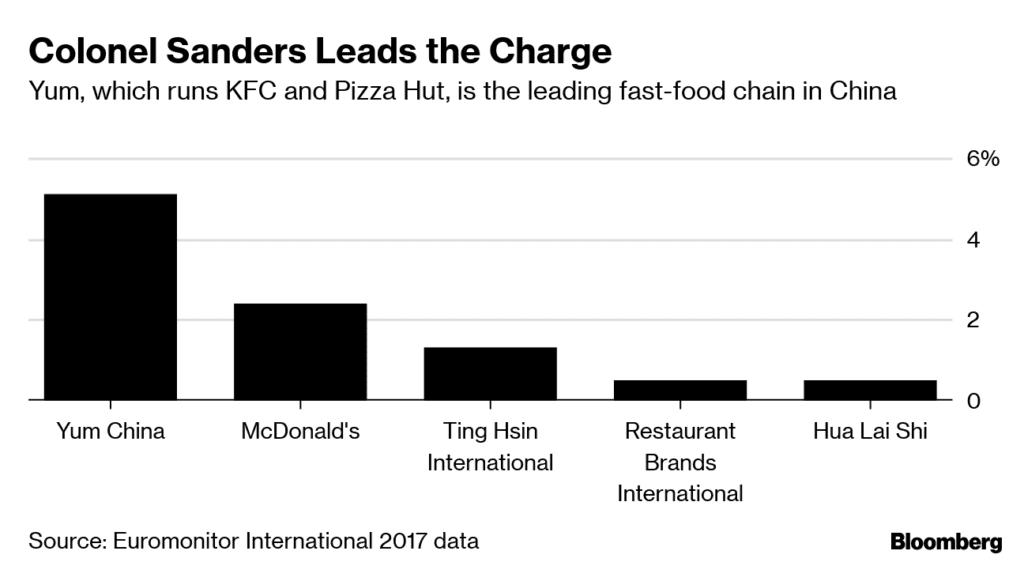Skift Take
Not to pile on Pizza Hut, but it's telling that the Yum brands that are resonating with Chinese diners are the same ones connecting with those in the U.S.: KFC and Taco Bell.
— Jason Clampet
KFC’s owner in China is pushing ahead with expansion plans, opening two stores a day in the world’s biggest consumer market and banking on technology to help it cut costs, even as carmakers and industrial companies signal demand there is deteriorating.
Yum China Holdings Inc., the nation’s biggest fast-food chain, which operates the KFC and Pizza Hut brands, is launching new restaurants at the second-fastest pace in 30 years and sees potential for over 11,000 more outlets, Chief Executive Officer Joey Wat said in an interview in Shanghai Tuesday.
While the trade war with the U.S. and the slowest economic growth since 1990 has companies like Caterpillar Inc., Volkswagen AG and Apple Inc. warning Chinese consumers are in retreat, Wat remains upbeat on the outlook for fried chicken and pan pizza. Yum’s positioning itself as a suite of fun, tech-driven brands aimed at China’s growing middle class, in stark contrast to their namesakes in the U.S. which focus on no-frills value fare.
“We believe the runway for growth is very strong,” said Wat, a former AS Watson Group U.K. managing director who has been CEO of Shanghai-based Yum China for a year. “We are in 1,200 cities in China, which seems like a lot, but there’s another thousand cities in China with no KFC. There’s huge space for growth.”
Yum China shares rose as much as 1.4 percent to $41.50 in New York trading Tuesday. They had already jumped 22 percent this year through Monday’s close.
Spun off in 2016 from parent Yum! Brands Inc., the fast-food giant’s promise to investors to deliver access to China’s blistering pace of growth has been unevenly fulfilled. Overall revenue has grown 25 percent and net income 33 percent since 2016, but Pizza Hut, which it’s pitching as a dining destination for middle-class families, has struggled to gain traction.

is pinning future growth on an all-in approach to using new technologies and consumer data. The company has amassed a trove of spending and demographics information from more than 160 million members in its KFC digital loyalty program and 50 million in Pizza Hut members. That’s allowed the chain to better forecast demand, cut food waste and boost profit margins. The savings have helped the chain avoid raising prices, Wat said.
Robotic Servers
KFCs here take payment by facial recognition, ice cream is served by robotic arms and customers can control the background music through their mobile phones like a new-age jukebox. Taco Bells in China have artful graffiti on the walls and hip-hop music, while Pizza Hut offers millennial inventions like fig and cranberry pizza.
The average consumer spend at KFC is only 30 yuan ($4.50), she said.
“Compared to businesses with much higher price points, we certainly have the advantage,” said Wat, who is 47 years old.
In the long term, the company sees potential for more than 20,000 outlets in China as it continues to push into less-developed cities beyond the crowded metropolises of Shanghai and Beijing, said Wat. When a KFC opens in a small Chinese town, jobs, logistics infrastructure and other restaurants and shops follow, making the chain a bellwether for economic development, she said.
China Hiccups
Yum China sales posted growth in the last quarter after store sales fell in the third quarter. Shares of the New York-listed fast food outlet have gained 22 percent percent this year, compared to the 3.5 percent gain in Yum! Brands.
Chief Financial Officer Jacky Lo warned of “market softness” in China last month and said it will be a “tough lap” in the first quarter compared to past performances.
The company has not managed to avoid the ongoing trade war between China and the U.S. After China slapped retaliatory tariffs on dairy imports from the U.S. last September, Yum China switched its cheese supply to Australian and New Zealand sources. Although hopes are high that Presidents Donald Trump and Xi Jinping will reach a deal this month that includes the immediate lifting of all tariffs, Wat would not commit to returning to American dairy farmers.
China Proposition
“We will adjust according to what’s going on, but a business of our size does not change its direction based on the news of the month,” she said.
When Yum China spun off on the New York Stock Exchange in 2016, it said that it was a chance for investors to capitalize on China’s growth along with U.S. standards of corporate governance. That proposition has not changed despite recent geopolitical developments, said Wat. Besides the trade war, China had also been in a stand-off with Canada over the arrest of a Huawei Technologies Co. executive.
“The result of the spinoff is that the combined stock price has increased to a level that both companies are very happy about,” she said.
—With assistance from Daniela Wei.
©2019 Bloomberg L.P.
This article was written by Bloomberg News from Bloomberg and was legally licensed through the NewsCred publisher network. Please direct all licensing questions to [email protected].
![]()



